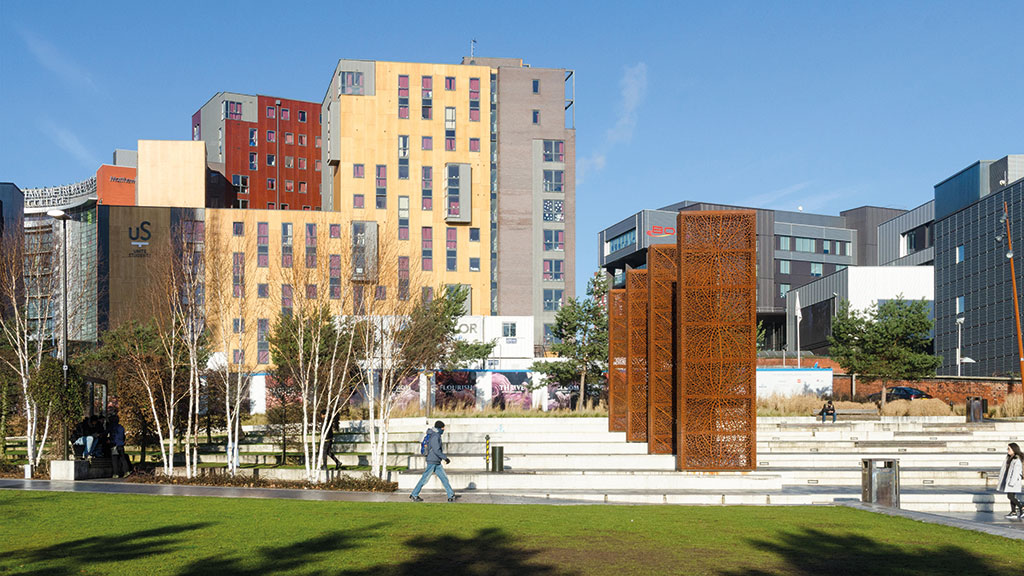Investing in commercial property: a tale of three markets
Student housing, care-home and self-storage owners are solid long-term growth stories in the commercial property sector. But is now the time to buy? Max King finds out.

Britain’s commercial property sector has traditionally been divided into three subsectors: industrial, offices and retail. In the 1980s and 1990s, retail outperformed while industrial properties struggled as consumer spending rose inexorably but the country deindustrialised. In the last ten years retail has lagged as household spending migrated online; industrial property, however, has outperformed thanks to the growth in logistics warehouses, notably to service online shoppers. But in recent years some of the best growth has come from three smaller subsectors: student housing, healthcare and self-storage – or beds, meds and sheds. Investors can gain access to each of these subsectors through real-estate investment trusts. Are they still worth a look?
The university boom
Student numbers reached 2.3 million in 2018; 75% are undergraduates and 80% are British. Despite the introduction of full tuition fees in 2012, more than half of school leavers go on to higher education. The annual number of applicants through the Universities and Colleges Admissions Service (UCAS) has doubled to 533,0000 in 25 years. Students used to live in college-owned halls of residence or in the private rental market. But demand outstripped both the willingness of the former to provide the necessary capital and the capacity of the latter.
Unite Group (LSE: UTG) was founded in 1991, initially to provide purpose-built student accommodation in the Bristol area. It now provides 75,000 beds across the country. Unite forms partnerships with universities to ensure high occupation: 92% of beds are reserved for 2019/2020 and 60% are guaranteed by universities. Occupancy of 98%-99% has consistently been achieved and rental growth is in the range of 3%-4% per annum. At mid-year the group’s assets stood at £3.2bn, of which £1bn was financed by borrowings, although the £1.4bn recent acquisition of Liberty Living will have increased gearing to around 35%.
MoneyWeek
Subscribe to MoneyWeek today and get your first six magazine issues absolutely FREE

Sign up to Money Morning
Don't miss the latest investment and personal finances news, market analysis, plus money-saving tips with our free twice-daily newsletter
Don't miss the latest investment and personal finances news, market analysis, plus money-saving tips with our free twice-daily newsletter
The shares, at 1,240p, trade at a 47% premium to net asset value (NAV), are valued at over 30 times earnings and yield just 2.6% but Unite says that the acquisition is “materially accretive to earnings”, while it is “confident of 3%-3.5% medium-term rental growth”. But even if the 12% growth in interim earnings and 8% growth in the dividend continues, it will take several years for the shares to look good value, despite the low-risk business model.
A turnaround story
Empiric Student Property (LSE: ESP) with 8,882 beds and £1bn of assets, seems much better value at 98p. It is on a 10% discount to NAV and yields 5%, but it is recovering from operational problems in 2017 that prompted a dividend cut. It focuses on smaller, higher-quality and more expensive buildings to appeal to graduates (46% of tenants) and overseas students (67%). GCP Student Living (LSE: DIGS), with £960m of assets, is of a similar size, but has less debt and an unblemished record. It trades on a 14% premium to NAV and yields 3.2%. It has 4,116 beds in 11 locations, but just 23% of its tenants are from the UK. As with Empiric, this may be an advantage as growth in international student numbers looks assured.
The rise of the health centre
The merger of Primary Health Properties (LSE: PHP) with MedicX leaves just two companies specialising in health centres: PHP, with £2.3bn of assets and Assura (LSE: AGR), with £2bn. Both trade on large premiums to NAV (38% and 50% respectively). But the attraction is dividend yields of 3.7% and 3.5% that are not only very safe, but also all but guaranteed to be at least inflation-indexed.
Both groups own purpose-built health centres, at least 90% of whose income comes directly or indirectly from the NHS on long-term leases, with the rest coming from pharmacies. Following the acquisition of MedicX, PHP now owns 488 of these, which are 99.5% occupied, while Assura has 560.
These health centres have replaced many of the old, small GP surgeries, but house many more doctors together with modern equipment, clinics, diagnostic testing, pharmacies and even day-surgery centres. Rental agreements provide for modest annual increases, but there is the potential for more if a property is modified or extended. Expansion comes from buying recently built premises or through funding a developer and then buying on completion, thereby avoiding risks connected with construction.
With only 20% of the PHP portfolio having a lease expiry of less than ten years, there is little opportunity or wish to trade the assets; the value of the shares lies in the rental stream. This makes them comparable to infrastructure funds, except that ownership of the assets is permanent. Strong performance in 2019 means that the shares of both are no longer great value, but they represent sound investments for those seeking secure, growing income.
The “meds” theme also covers two smaller companies that own residential care homes, Impact Healthcare (LSE: IHR) and Target Healthcare (LSE: THRL). Target, with £600m of property assets and £100m of net debt, operates 69 purpose-built care homes. Impact, with £311m of property assets and some £10m of net cash, owns 84 care homes and two healthcare facilities leased to the NHS. In both cases, the care homes are leased to high-quality operators for the long term, with built-in rental increases. Both shares seem attractive, with Target trading on a 7% premium to NAV and yielding 5.8%, while Impact trades on a 2% premium and yields 5.7%.
Note, however, that the number of care beds in the UK has fallen some 20% since its peak of around 550,000 in 1997. The NHS and local authorities have not been prepared to increase payments to operators by enough to cover escalating costs. In 2011 Southern Cross got into trouble amid an 8% drop in occupancy, the result of fewer referrals due to public-spending cuts. It could not pay its escalating rent bill and became insolvent. Well-run care homes are the most cost-effective way of caring for the elderly, but governments have repeatedly pursued the false economy of squeezing the private operators, who account for nearly all capacity. If this keeps happening, Target and Impact could find their rental income under pressure from struggling operators.
Businesses need more storage space
The self-storage market conjures up images of warehouses crammed with personal possessions. That, however, probably only accounts for a small part of the UK’s 20 million square feet of lettable area, with rates varying from £16 per square foot (sq ft)in Scotland to £28 in London. Personal storage is an important part of the market, but the business market is key. For small businesses, storing goods, records and stock at a self-storage unit or lock-up garage is likely to prove much cheaper than doing so at an office or in a shop, particularly with the increasing number of online entrepreneurs operating from home.
Hence the success of the two listed specialists, Safestore (LSE: SAFE) and Big Yellow (LSE: BYG), trading at premiums of 52% and 75% to NAV and yielding 2.2% and 2.8% respectively. Safestore, with 149 stores (including 22 in the Paris region) has 6.5 million sq ft of lettable area valued at £1.4bn and Big Yellow, with 75 stores, has 4.6 million sq ft valued at £1.5bn.
Big Yellow’s recent interim results revealed revenue and profit growth of 3.4% and 6% respectively, thanks to a small increase in like-for-like occupancy and a 1.9% increase in rent per sq ft. Lettable area increased only 0.7%, although there are 13 development sites, of which six have planning permission. Big Yellow also owns 20% of Armadillo, with 25 stores, which it presumably hopes to buy the rest of. That would give it 6.6 million sq ft in all.
Safestore’s recent final results showed a 5.6% increase in revenue and a rise in earnings per share of 6.3%, thanks to increases of 3.5% in average occupancy and a 1% in average rates. It plans four new stores in 2019/2020, but insists that its “top priority remains the growth opportunity of the 1.5 million sq ft of currently unlet space”. Big Yellow’s occupancy of 83.4% is higher, despite its larger stores, giving less unlet potential and its net rent per sq ft of £27.73 is 6% higher than Safestore’s, despite the latter’s focus on London and the southeast (70 stores). Both shares trade on 27 to 28 times underlying earnings, so they look expensive despite the solid record and prospects.
ASR strategist Zahra Ward-Murphy acknowledges that “the beds, meds and sheds theme is not new and these sectors have been outperforming for some time. Nonetheless, we like these sectors because they are underpinned by secular demand drivers and therefore should prove relatively resilient to any further slowdown in growth”. Business risks look low and dividend yields are reasonable in relation to low interest rates and bond yields, while dividends should climb steadily.
However, with the exception of the recovery story of Empiric and the historically risky care-home owners, valuations are high and vulnerable to market setbacks, so investors should wait for the next general sell-off before eyeing them up.
Get the latest financial news, insights and expert analysis from our award-winning MoneyWeek team, to help you understand what really matters when it comes to your finances.

Max has an Economics degree from the University of Cambridge and is a chartered accountant. He worked at Investec Asset Management for 12 years, managing multi-asset funds investing in internally and externally managed funds, including investment trusts. This included a fund of investment trusts which grew to £120m+. Max has managed ten investment trusts (winning many awards) and sat on the boards of three trusts – two directorships are still active.
After 39 years in financial services, including 30 as a professional fund manager, Max took semi-retirement in 2017. Max has been a MoneyWeek columnist since 2016 writing about investment funds and more generally on markets online, plus occasional opinion pieces. He also writes for the Investment Trust Handbook each year and has contributed to The Daily Telegraph and other publications. See here for details of current investments held by Max.
-
 Football fans issued warning over ticket scams ahead of 2026 World Cup
Football fans issued warning over ticket scams ahead of 2026 World CupSantander customers lost more to football scams in the first six months of 2025 compared to the same period in 2024, when total losses surged due to the Euros
-
 Nationwide fined £44 million over “inadequate” anti-money laundering systems
Nationwide fined £44 million over “inadequate” anti-money laundering systemsFailings in Nationwide’s financial crime processes between October 2016 to July 2021 meant one criminal was able to deposit £26 million from fraudulent Covid furlough payments in just eight days.
